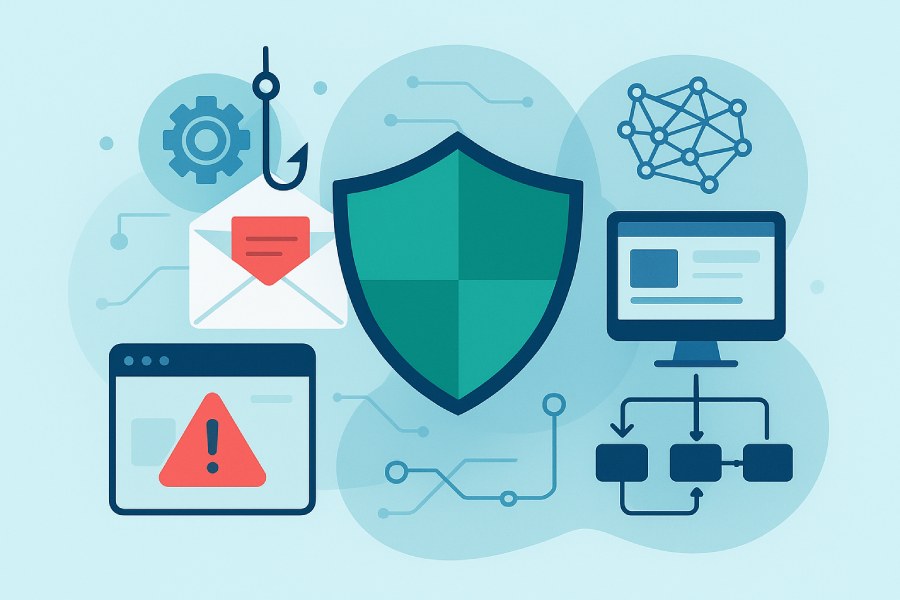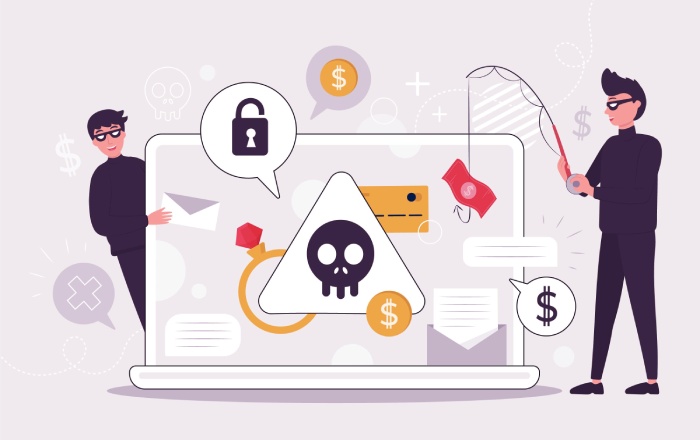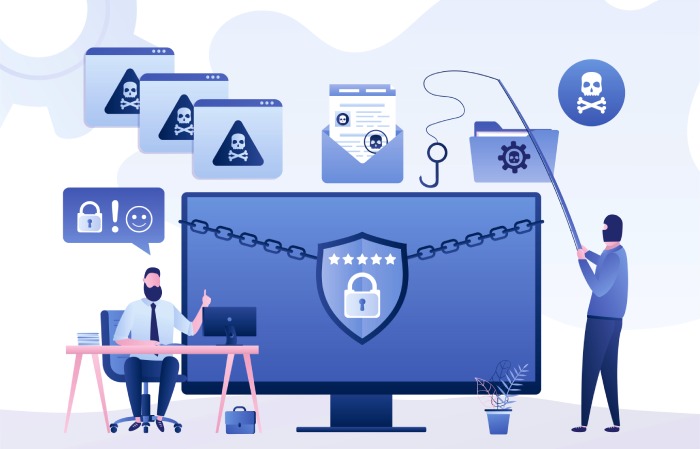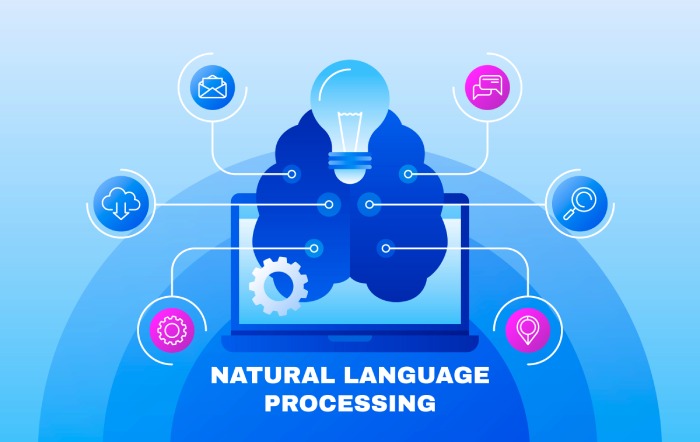Phishing is a sophisticated form of cyberattack where malicious actors attempt to deceive individuals into divulging sensitive information such as login credentials, financial details, or personal data. These attacks commonly employ email as a vector, making phishing detection and email filtering critical components of modern cybersecurity protocols. The impact of phishing extends beyond mere inconvenience; it often results in identity theft, significant financial loss, and compromised network security.
To combat phishing effectively, organizations deploy anti-phishing software and implement multi-layered defenses that include two-factor and multi-factor authentication. The seriousness of phishing threats necessitates not only technological solutions but also user education through security awareness training and phishing awareness campaigns to bolster social engineering defense.
The Evolution of Phishing Attacks in the Digital Age
Phishing attacks have evolved dramatically from simple bulk email scams to highly targeted spear phishing and whaling attacks. Attackers now employ sophisticated phishing kits and use web phishing tactics to craft convincing replicas of legitimate websites, thus enabling credential harvesting prevention to become a significant focus in the cybersecurity landscape.
As phishing has grown more complex, so too have the detection techniques. Early responses relied primarily on simple email filtering tactics and blacklist databases, but today’s threats require dynamic, automated solutions that integrate behavioral analytics and phishing threat intelligence. These advanced approaches facilitate phishing attack mitigation by identifying subtle anomalies in email headers, content, and sending domains.
Organizations like PhishMe (Cofense), Proofpoint, Mimecast, and Barracuda Networks have pioneered phishing protection solutions that incorporate phishing email analysis and phishing kit detection to identify and quarantine suspicious content effectively. These technologies are complemented by industry standards such as domain-based message authentication protocols — including DMARC, DKIM, and SPF records — which form the backbone of email authentication practices and spoofing prevention.
Overview of Automated Anti-Phishing Techniques
Automated anti-phishing techniques harness the power of artificial intelligence, machine learning, and advanced data analytics to combat phishing threats at scale. Central to these techniques is the use of email security gateways and phishing email quarantine systems, developed by vendors like Microsoft Defender for Office 365, Symantec (Broadcom), and Trend Micro.
Automated systems incorporate phishing URL blacklists, URL filtering, and malware detection to block harmful links before they reach end users. These solutions act as a frontline defense, integrating with network security and endpoint protection to enforce zero-trust security architectures, which minimize the lateral movement of threats even if an initial phishing event succeeds.
Moreover, integration with security information and event management (SIEM) platforms offered by IBM Security, FireEye, and Cisco Talos allows for real-time incident response and deeper forensic analysis, strengthening overall cybersecurity posture. Email encryption and data loss prevention mechanisms are also indispensable automated countermeasures that help safeguard sensitive communications and data.
Machine Learning and AI in Phishing Detection
Machine learning anti-phishing technologies represent a paradigm shift in defense capabilities, enabling the detection of novel phishing variants through training on vast datasets of phishing and legitimate emails. Companies like Darktrace, Avast, McAfee, and Kaspersky Lab utilize behavioral analytics to detect suspicious activities by analyzing user behavior and email metadata.
Such systems can detect patterns indicative of phishing, including anomalies in sender IP addresses, timing of emails, and message content features that traditional signature-based methods often miss. Leveraging phishing threat intelligence feeds from sources like Google Safe Browsing and Trend Micro Phish Insight further enhances detection accuracy by providing contextual awareness of emerging threats.
Integrating behavioral analytics with phishing email analysis strengthens the ability to pinpoint complex attacks such as spear phishing and whaling. Additionally, these AI-driven techniques significantly improve phishing domain takedown efforts by identifying and cataloging new phishing domains rapidly, limiting attacker infrastructure longevity.
Role of Natural Language Processing in Identifying Phishing Content
Natural language processing (NLP) plays an instrumental role in understanding and identifying phishing content embedded within emails and websites. NLP techniques analyze textual data to detect linguistic cues such as urgency, persuasive language, and suspicious asking patterns that attackers typically employ in phishing scams.
Anti-phishing software developed by companies such as Sophos, Bitdefender, and Webroot leverages NLP to dissect email body text for phishing indicators, thereby improving phishing email analysis beyond just surface-level header checks. The integration of NLP with machine learning models helps create nuanced phishing detection systems that can distinguish legitimate business communications from malicious ones, reducing false positives.
NLP also assists in enhancing phishing simulation and phishing reporting tools, enabling organizations to replicate real-world phishing campaigns in security awareness training to better prepare users. By combining these methods with traditional cybersecurity protocols like two-factor authentication and domain-based message authentication, security teams can robustly defend against social engineering attacks.
Statistical Data: Effectiveness of Automated Anti-Phishing Techniques in Reducing Incidents
- Organizations deploying machine learning anti-phishing solutions report a 50% reduction in successful phishing attempts
- Email filtering combined with DMARC, DKIM, and SPF implementation reduces spoofing-related breaches by 70%
- Companies utilizing security awareness training alongside automated detection technologies see a 60% decrease in reported phishing incidents
- Phishing domain takedown initiatives reduce active phishing domains by up to 80% within weeks of detection
Sources: PhishMe (Cofense) Annual Report, Proofpoint Threat Insights, Microsoft Security Intelligence.
URL and Domain Analysis for Suspicious Link Detection
Effective phishing detection hinges significantly on accurate URL and domain analysis, which helps identify suspicious links designed to harvest credentials or distribute malware. Robust anti-phishing software platforms like Proofpoint and Trend Micro leverage domain-based message authentication protocols such as DMARC, DKIM, and SPF records to verify the legitimacy of email sender domains. This email authentication process prevents spoofing by ensuring that the domain in the email header matches authorized senders, a critical element of spoofing prevention.
Phishing threat intelligence feeds, including phishing URL blacklists maintained by entities such as Google Safe Browsing and Cisco Talos, are integrated into URL filtering mechanisms to identify and block known malicious domains. More advanced solutions incorporate phishing kit detection to discover new phishing infrastructure rapidly. These kits, often utilized to deploy exploitative phishing pages, can be detected by analyzing domain registration data, SSL certificates, and URL patterns for anomalies. Moreover, phishing domain takedown efforts, coordinated by cybersecurity organizations, help eliminate fraudulent domains quickly, reducing the lifespan of phishing campaigns.
Complementing static rules, machine learning anti-phishing algorithms analyze real-time URL behavior and metadata, identifying phishing attempts even if the URL is not yet blacklisted. Behavioral analytics supplements phishing URL analysis by scrutinizing request patterns and redirection techniques commonly used in web phishing attacks. This layered approach enhances credential harvesting prevention and reduces risk from novel phishing URLs.
Email Filtering Systems and Their Automation
Email filtering serves as the frontline defense against phishing emails, operating through email security gateways such as those provided by Barracuda Networks, Mimecast, and Microsoft Defender for Office 365. These systems use a blend of signature-based detection, heuristic scanning, and anomaly detection for malware detection and phishing attack mitigation.
Automated email filtering incorporates domain-based message authentication checks through DMARC, DKIM, and SPF validations to filter fraudulent senders effectively. Advanced phishing email analysis is performed in-line, quarantining suspicious messages in the phishing email quarantine to prevent user exposure. Email encryption technologies are also employed to protect data in transit, ensuring secure communication channels.
Integration with security information and event management (SIEM) platforms enables centralized monitoring and incident response coordination, enhancing cybersecurity protocols. Additionally, email filtering automation works symbiotically with phishing reporting tools and user education initiatives, such as phishing simulation campaigns provided by KnowBe4 and PhishMe (Cofense), to bolster social engineering defense.
Behavioral Analysis to Detect Phishing Attempts
Behavioral analytics is an increasingly vital component of phishing detection strategies. Platforms like Darktrace and FireEye deploy AI-driven models to monitor user and system behaviors continuously, identifying deviations indicative of phishing attempts or related social engineering attacks. This method excels in detecting spear phishing and whaling attacks, which often bypass traditional signature-based detection due to their targeted nature.
By analyzing unique behavioral signatures, such as irregular login attempts or suspicious email interactions, behavioral analytics can trigger multi-factor authentication prompts to mitigate potential breaches. Coupling this with zero-trust security frameworks limits access until the user identity is fully authenticated, significantly enhancing identity theft protection.
Behavioral analysis also strengthens endpoint protection by detecting malware proliferation post-phishing infection attempts, thereby enabling rapid incident response. This dynamic defense complements email filtering and URL filtering, contributing to holistic network security and cyber hygiene maintenance.
Challenges and Limitations of Automated Anti-Phishing Systems
Despite significant advances, automated anti-phishing systems face inherent challenges. Sophisticated phishing kits and polymorphic phishing domains can evade phishing URL blacklists for extended periods. Attackers frequently employ social engineering tactics that mimic legitimate communications, making phishing email analysis complex for automated systems.
Automated systems sometimes generate false positives, quarantining legitimate emails and disrupting business communications. Additionally, certain phishing links use obfuscation techniques such as URL shortening and homograph attacks that complicate spoofing prevention and domain verification.
Moreover, reliance solely on technical controls without active user education and security awareness training can leave organizations vulnerable. Attackers continually adapt to circumvent multi-factor authentication protocols by exploiting user behavior or deploying novel malware variants that evade conventional malware detection.
Finally, multi-layered integrations often require considerable resources and expertise to configure and maintain, posing operational challenges for small to medium enterprises lacking dedicated cybersecurity teams.
Future Trends and Innovations in Anti-Phishing Technology
The future of anti-phishing technology lies in refining machine learning anti-phishing models to enhance predictive analytics and reduce false positives. Advancements in behavioral analytics combined with real-time phishing threat intelligence will improve early detection of zero-day phishing URLs and sophisticated web phishing campaigns.
Cloud-based email security gateways, such as those provided by Symantec (Broadcom) and IBM Security, will increasingly leverage automation and orchestration to integrate incident response workflows, enabling faster remediation of phishing attacks. Enhanced phishing reporting tools equipped with natural language processing will streamline user-driven phishing awareness campaigns, promoting better cyber hygiene.
Emerging technologies like browser anti-phishing tools will become more intelligent, embedding phishing URL blacklists directly into endpoint protection layers to block malicious web domains proactively. The integration of zero-trust security architectures with adaptive multi-factor authentication mechanisms will further reduce attack surfaces exposed during phishing incidents.
Furthermore, collaboration between cybersecurity vendors such as Kaspersky Lab, Sophos, and Bitdefender and public threat intelligence sharing platforms will expedite phishing domain takedown operations and improve the collective defense against phishing kits.
As artificial intelligence and behavioral analytics evolve, they are expected to play pivotal roles in strengthening social engineering defense and spear phishing mitigation, setting the stage for more resilient cybersecurity protocols in the ongoing battle against phishing threats.
Key Takeaways
- URL and domain analysis leveraging DMARC, DKIM, and SPF protocols is critical for preventing phishing domain spoofing and credential harvesting.
- Automation in email filtering, combined with email encryption and phishing email quarantine, enhances phishing attack mitigation within email security gateways.
- Behavioral analytics and machine learning anti-phishing technologies improve the detection of sophisticated, targeted phishing attempts like spear phishing and whaling.
- Automated anti-phishing systems face challenges such as evolving phishing kits, false positives, and the need for comprehensive user education.
- Future anti-phishing innovations will focus on AI-driven predictive analytics, zero-trust security integration, cloud-based orchestration, and collaborative threat intelligence sharing.







